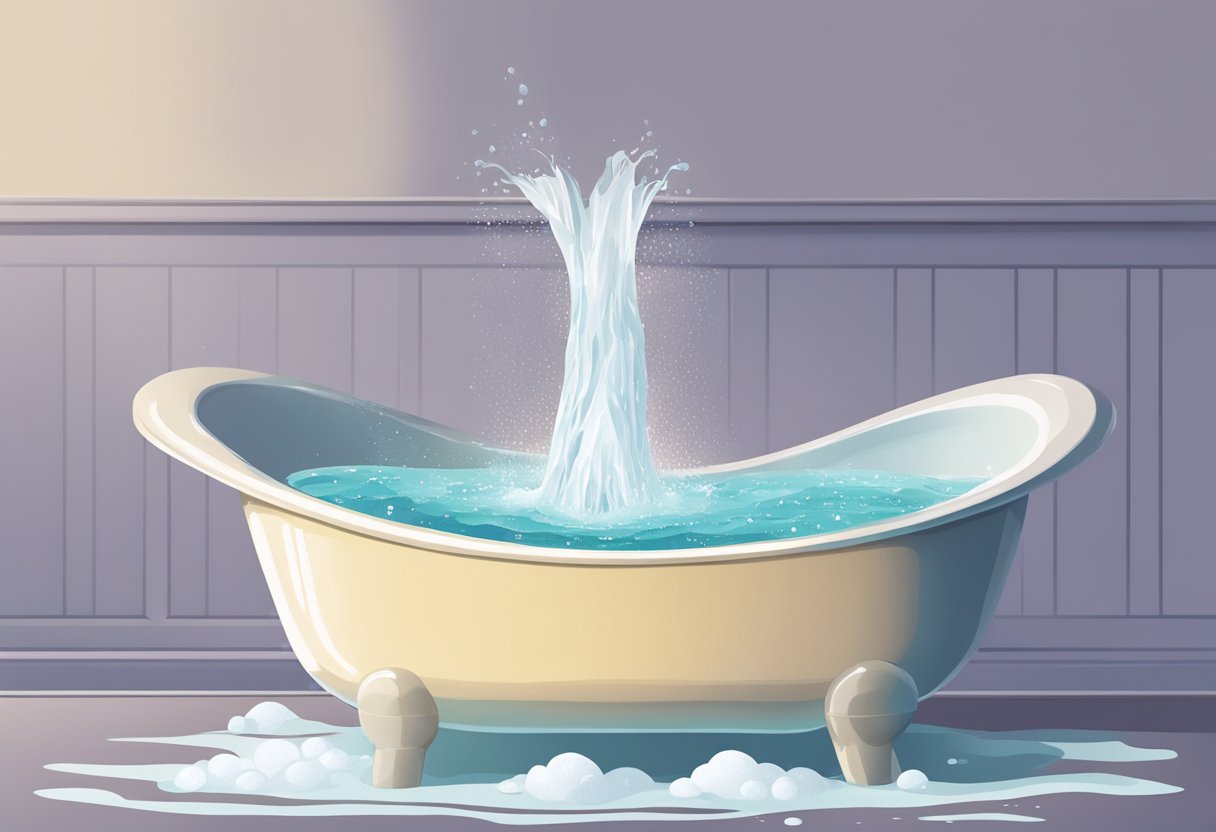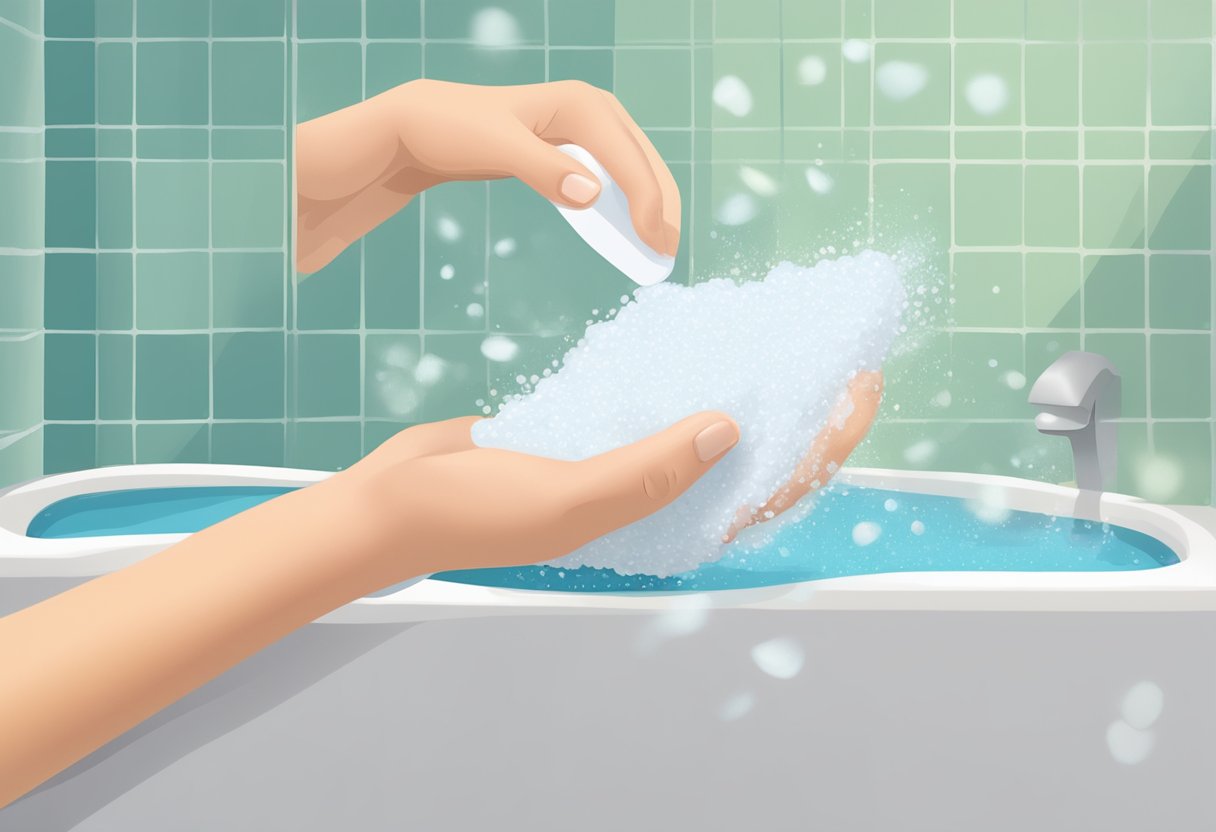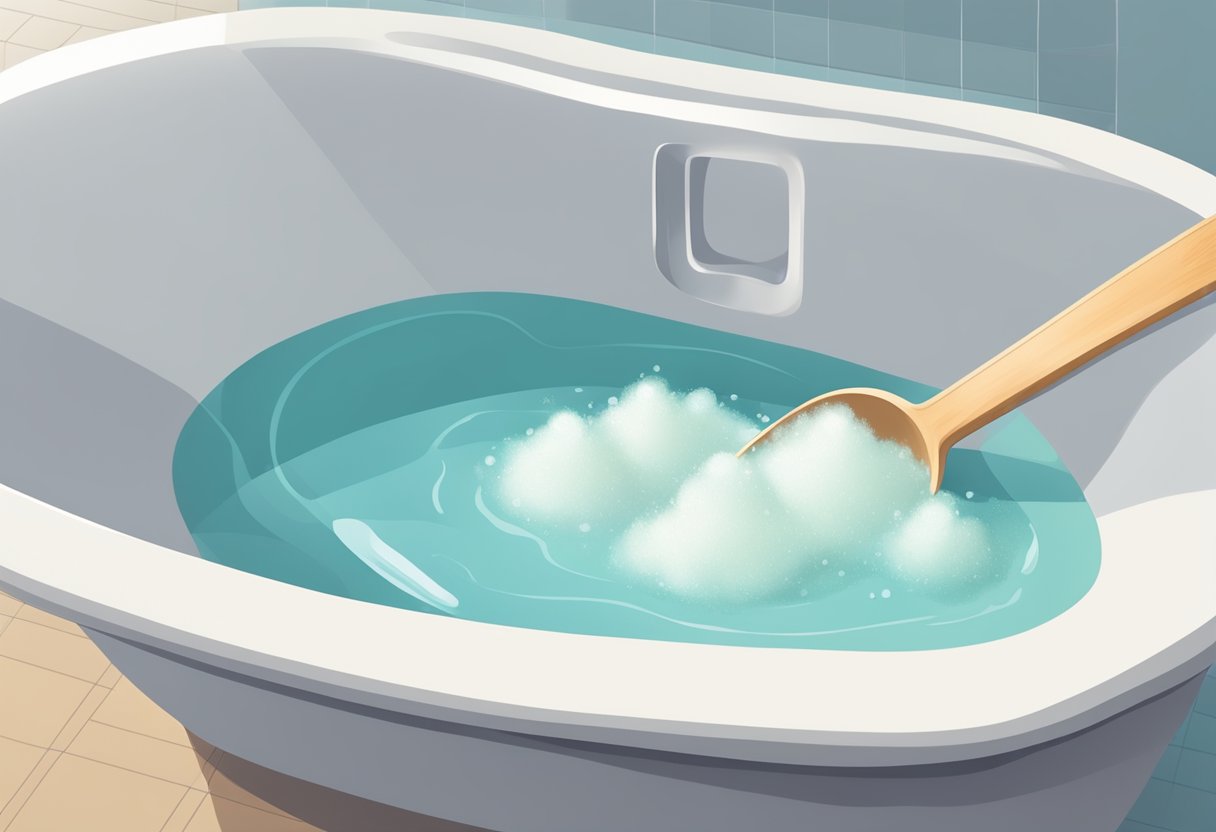Epsom salt baths have been a popular home remedy for a variety of ailments for centuries. Epsom salt is a naturally occurring mineral compound of magnesium and sulfate, which are both readily absorbed through the skin. The benefits of Epsom salt baths are numerous, including relieving muscle aches and pains, reducing inflammation, improving circulation, and promoting relaxation.

One of the most common questions people have when it comes to taking an Epsom salt bath is how much salt to use. The answer depends on the size of the bathtub and the desired effect. For a standard-sized bathtub, it is recommended to use 1 to 2 cups of Epsom salt. However, for larger garden-style tubs, the quantity can be increased to 2 to 4 cups. For foot soaks or smaller tubs, a half to one cup is usually sufficient. It is important to note that using too much Epsom salt can lead to drying out of the skin, so it is best to start with a smaller amount and increase gradually if necessary.
Overall, Epsom salt baths can be a great way to relax and promote overall wellness. By following the recommended guidelines for how much salt to use, individuals can experience the benefits of this natural remedy without any negative side effects.
Epsom Salt Basics

What Is Epsom Salt?
Epsom salt, also known as magnesium sulfate, is a naturally occurring mineral compound that contains magnesium, sulfur, and oxygen. It has a crystalline structure and is often used in bath salts, foot soaks, and other beauty and wellness products. Epsom salt is named after the town of Epsom in Surrey, England, where it was first discovered in the 17th century.
Benefits of Epsom Salt Baths
Epsom salt baths are a popular way to relax, soothe sore muscles, and improve overall health and wellness. Here are some of the benefits of taking an Epsom salt bath:
-
Relieves Muscle Pain and Tension: Epsom salt baths are believed to help ease muscle pain and tension by reducing inflammation, improving circulation, and promoting relaxation.
-
Reduces Stress and Anxiety: The magnesium in Epsom salt is thought to help reduce stress and anxiety by promoting relaxation and calming the nervous system.
-
Improves Sleep: Taking an Epsom salt bath before bed may help improve sleep quality by promoting relaxation and reducing stress.
-
Soothes Skin Irritations: Epsom salt baths are believed to help soothe skin irritations, such as eczema and psoriasis, by reducing inflammation and promoting healing.
-
Detoxifies the Body: Epsom salt is thought to help detoxify the body by drawing out toxins and impurities through the skin.
How Much Epsom Salt to Use in a Bath
The amount of Epsom salt to use in a bath depends on the size of the bathtub and the desired effect. As a general rule, aim for about 1-2 cups of Epsom salt for a standard bathtub. For larger garden-style tubs, you can increase the quantity to 2-4 cups. For foot soaks or smaller tubs, a half to one cup is usually sufficient.
It is important to note that Epsom salt baths should be avoided by those with certain medical conditions, such as high blood pressure, diabetes, and kidney disease. It is always best to consult with a healthcare provider before starting any new wellness routine.
Preparing Your Bath

Ideal Water Temperature
Before adding Epsom salt to your bath, it’s important to ensure that the water temperature is just right. Ideally, the water should be warm, but not too hot. Hot water can be drying to your skin, and it can also cause discomfort. A good rule of thumb is to aim for a temperature between 92 and 100 degrees Fahrenheit. This will help to ensure that your bath is both relaxing and beneficial.
Dissolving Epsom Salt
Once you’ve filled your tub with warm water, it’s time to add the Epsom salt. The amount of salt you use will depend on the size of your tub. For a standard-sized bathtub, it’s recommended to use 1 to 2 cups of Epsom salt. If you have a larger tub, you can increase the amount to 2 to 4 cups. For smaller tubs or foot soaks, a half to one cup is usually sufficient.
To ensure that the Epsom salt dissolves properly, it’s important to add it to the water while the tub is filling up. This will help to ensure that the salt is evenly distributed throughout the water. You can also stir the water to help dissolve the salt more quickly. Once the salt is fully dissolved, you can get in and enjoy your relaxing and rejuvenating bath.
In summary, preparing your Epsom salt bath involves filling your tub with warm water at the ideal temperature and adding the appropriate amount of Epsom salt, which should be dissolved before getting in. By following these simple steps, you can enjoy the many benefits that Epsom salt baths have to offer.
Recommended Dosage

General Guidelines
Epsom salt is a popular addition to baths for its potential health benefits, including relaxation, relief from sore muscles, and improved skin health. The recommended dosage of Epsom salt for a bath varies depending on the size of the bathtub and the desired effect.
As a general guideline, for a standard bathtub, it is recommended to use about 1 to 2 cups of Epsom salt. For larger garden-style tubs, the quantity can be increased to two to four cups. However, for foot soaks or smaller tubs, a half to one cup is usually sufficient.
It is important to note that exceeding the recommended dosage can result in skin irritation or dehydration. Therefore, it is essential to follow the guidelines and not to exceed the recommended amount.
Adjustments for Specific Needs
For individuals with specific needs, such as skin conditions or body weight, adjustments to the recommended dosage may be necessary. For example, individuals with psoriasis, eczema, or other skin conditions may benefit from using one cup of Epsom salt in their bath, while those with dry or itchy skin may benefit from two cups.
David Jockers DC, MS, CSCS recommends that the quantity of salt used should correlate with body weight. He suggests using one cup of Epsom salt per 50 pounds of body weight. Soaking for 20-40 minutes is also recommended.
It is important to consult with a healthcare provider before making any adjustments to the recommended dosage based on individual needs.
Safety and Precautions

Skin Sensitivity
While Epsom salt baths are generally considered safe, some individuals may experience skin irritation or sensitivity. It is recommended to test a small area of skin before taking a full bath. If any redness, itching, or discomfort occurs, discontinue use immediately.
It is also important to note that using too much Epsom salt in a bath can lead to skin dryness and potential irritation. The Mayo Clinic recommends using 2 cups of Epsom salt per gallon of warm water to avoid these issues.
Health Considerations
Individuals with certain health conditions should consult with their healthcare provider before using Epsom salt baths. These conditions include:
- Diabetes
- High blood pressure
- Kidney problems
- Heart problems
Additionally, pregnant women should consult with their healthcare provider before using Epsom salt baths.
It is important to follow the recommended guidelines for Epsom salt use and to avoid overuse. Excessive Epsom salt can irritate the skin and cause discomfort. It is also important to stay hydrated before and after taking an Epsom salt bath to prevent dehydration.
Overall, Epsom salt baths can be a relaxing and beneficial addition to a self-care routine when used safely and in moderation.
Enhancing Your Bath Experience

Taking a bath with Epsom salt is already a relaxing experience, but adding a few extra touches can take it to the next level. Here are some suggestions for enhancing your bath experience:
Essential Oils and Aromatherapy
Adding a few drops of essential oils to your bathwater can provide a soothing and calming effect. Some popular choices include lavender, chamomile, and eucalyptus. Be sure to mix the essential oils with a carrier oil before adding them to the bathwater, as undiluted essential oils can irritate the skin.
Bath Additives
There are a variety of bath additives available that can provide additional benefits to your bath. Some popular options include:
- Baking soda: can help soothe skin irritation and soften the water
- Coconut oil: can moisturize and nourish the skin
- Honey: can help soothe and moisturize the skin
- Milk: can help soften and moisturize the skin
When using bath additives, be sure to follow the instructions on the packaging and avoid using too much, as it can make the water too slippery and difficult to get out of the tub.
By incorporating these simple additions to your bath routine, you can create a spa-like experience in the comfort of your own home.
After the Bath

Hydration and Moisturizing
After taking an Epsom salt bath, it is important to hydrate the body by drinking plenty of water. This helps to replenish fluids lost during the bath and prevent dehydration. In addition, Epsom salt can be drying to the skin, so it is recommended to moisturize the skin after the bath. Applying a moisturizer or body oil can help to lock in moisture and keep the skin soft and supple.
Rest and Relaxation
Taking an Epsom salt bath can be a relaxing and rejuvenating experience, so it is recommended to rest and relax after the bath. This can help to prolong the benefits of the bath and promote overall wellness. Engaging in calming activities such as reading a book or listening to soothing music can help to promote relaxation and reduce stress. It is also recommended to avoid strenuous activity after the bath, as this can be counterproductive to the relaxation achieved during the bath.
Overall, taking an Epsom salt bath can be a great way to promote relaxation and wellness. By following these simple steps after the bath, individuals can maximize the benefits of the bath and promote overall health and well-being.
Frequently Asked Questions

What is the recommended amount of Epsom salt for a standard bath?
For a standard bathtub, it is recommended to use about 1 to 2 cups of Epsom salt. However, if you have a larger garden-style tub, you can increase the quantity to two to four cups. For foot soaks or smaller tubs, a half to one cup is usually sufficient.
Are there any negative side effects associated with Epsom salt baths?
Epsom salt baths are generally safe for most people. However, using too much Epsom salt can cause skin irritation, dryness, and itching. It is also important to note that Epsom salt baths should be avoided by people with open wounds, skin infections, or other health conditions that may be exacerbated by soaking in water.
How frequently is it safe to take Epsom salt baths within a week?
It is generally safe to take Epsom salt baths 2-3 times a week. However, it is important to consult with a healthcare provider before starting any new health regimen, especially if you have any underlying health conditions.
Is it necessary to shower after taking an Epsom salt bath?
It is not necessary to shower after taking an Epsom salt bath. However, some people may choose to rinse off with warm water to remove any excess salt or residue from their skin.
What duration is ideal for soaking in an Epsom salt bath?
The ideal duration for soaking in an Epsom salt bath is 20-30 minutes. This allows enough time for the magnesium and sulfate in the Epsom salt to be absorbed through the skin.
What are the benefits of taking an Epsom salt bath?
Epsom salt baths are thought to have several benefits, including reducing stress, easing muscle soreness, promoting relaxation, and improving sleep. Additionally, the magnesium in Epsom salt may help improve skin hydration and reduce inflammation. However, more research is needed to fully understand the potential benefits of Epsom salt baths.

